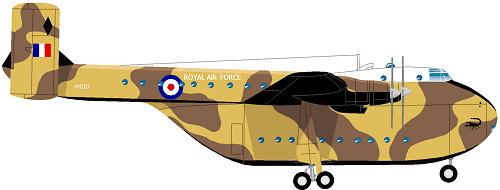Gallery No 3 - Blackburn Beverley
Aircraft - 1 Images
My thanks to Roger Dunn and the MOD for supplying these images.Wikipedia for text.
|
The Blackburn Beverley was a heavy-lift transport aircraft
which served with the Royal Air Force between 1956 and 1967. Only forty
seven Beverleys were built, but they served with great distinction with
30, 34, 47, 53 and 84 Squadrons and 242 Operational Conversion Unit.
The Beverleys were kept busy in many countries including Aden, Brunei,
Kenya, East and West Malaysia and Zanzibar.
The Beverley was descended from the tank carrying heavy-lift General Aircraft GAL50 Hamilcar glider which saw service in World War Two. In response to an Air Ministry Specification for a heavy-lift short range transport aircraft,General Aircraft, the manufacturers of the Hamilcar, produced the GAL60 Universal Freighter, the Beverley's immediate predecessor. General Aircraft then merged with Blackburn before the GAL60 was complete. The GAL60 was built at Feltham, Middlesex, then dismantled and taken to Brough, East Yorkshire, reassembled and first flown on 20th June 1950, by which time it had become the Blackburn and General Aircraft Universal Freighter. I was told by a craftsman who worked at Brough at that time, that bets were actually taken on whether the aircraft would get off the ground. The GAL60 was not an attractive or elegant aircraft. It had an enormous box-like body with a large tail boom. Each side of the tail plane had a large fin and rudder. Access to the freight bay was by rear opening doors and a hand pumped hydraulic ramp. Four radial Hercules engines mounted on a high wing powered the aircraft. The undercarriage was a fixed tricycle type. A second aircraft, the Mk2, was built in 1950/51. This incorporated some changes, altering the shape to more or less what would become the Beverley. Clamshell doors replaced the ramp and door assembly. The clamshell doors were designed to be removable for supply dropping. The boom was modified into a passenger area which could hold 36 people. The engines were up-rated to Bristol Centaurus, each developing 2850Hp. The propellers had a then novel reverse pitch feature which made for a very short landing. Years later, as an Air Despatcher with the RASC/RCT (Royal Army Service Corps/Royal Corps of Transport), it used to amuse me watching people stare incredulously at a Beverley reversing under its own power. The first order for 20 aircraft was placed for the RAF in late 1952, and the aircraft was renamed as the Beverley C Mk1. XB259 was the first off the production line. 47 Sqn was the first Beverley squadron, receiving its first two aircraft 1n March 1955. For those who like coincidences, there were 47 Beverleys made, the first squadron to receive them was numbered 47, and 47 Squadron was raised in Beverley - the city which gave its name to the aircraft, and the home of the last of the type. Before reaching squadron service, these ungainly aircraft had already shown what they could do. One had delivered very bulky drilling equipment to a rough desert airstrip in Oman, and another, mining equipment in Canada. Others were demonstrating the Beverley's usefulness for paratrooping and heavy airdrops. Beverley Details An important part of the Beverley's work was in the air-dropping
of supplies. Typical loads were:- The capacious hold could carry a wide range of goods and equipment for air-landing:- Helicopters, Missiles, Small Aircraft, Fuel, Lorries and other vehicles of various kinds. Main source: 'Blackburn Beverley' by Bill Overton. ISBN 0-904597-62-8
|
Some aircraft may appear identical but there are differences which will not be discernible from the image.
(Be patient with loading)
 |
84 Squadron |
(Be patient with loading)